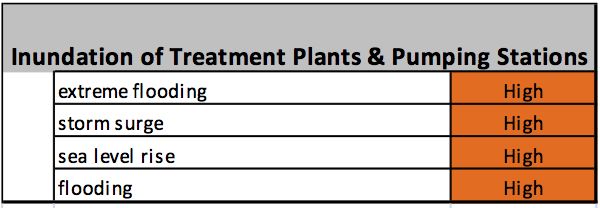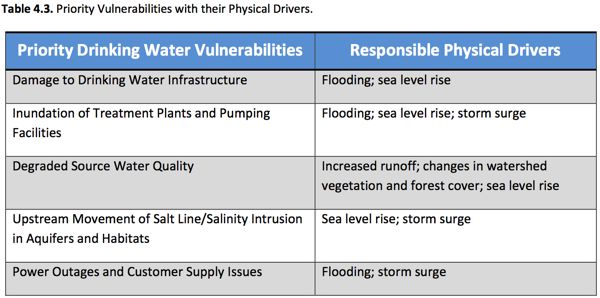Man Made, Foreseen, Preventable
“Rosebud”
Inundation of Treatment Plants and Pump Stations/Damage to Drinking Water Treatment Infrastructure
Regional Level Action ~ Update 100‐year and 500‐year Floodplain Maps
Regardless of the quality of science available to determine the impacts of climate change on physical conditions in the Basin, specific inundation risks can only be effectively evaluated with updated shoreline topographical information.
Utility Level Action ~ Evaluate Placement of New Construction and Materials Resiliency
Drinking water utilities should evaluate the placement of new construction, monitoring equipment, and other infrastructure to avoid low‐lying areas or locations vulnerable to storms and other harsh weather conditions. Ranges of potential flooding should be evaluated using the best available science. Adaptations can be refined as more information becomes available about specific impacts of sea level rise, potential increases in streamflow and other changes in the basin that pose a risk to drinking water utilities. Utilities should also evaluate and incorporate use of more resilient construction materials during day‐to‐day upgrades.
Increased Spills and Accidents/Power Outages and Customer Supply Issues
Regional Level Action ~ Support the XXXXXXXX Regional Early Warning System
The XXXXXXX Regional Early Warning System notifies drinking water utilities in the event of accidental contamination in certain areas of the XXXXXXX Basin. The system provides critical information to utilities so they can respond swiftly and appropriately to unexpected threats. Efforts to expand and improve this system must be supported to ensure the continued protection of drinking water supplies in the Basin.
Addresses: Increased Spills and Accidents
Involves: EPA,XXXX, state government, USCG, municipal government, Offices of Emergency Management
Utility Level Action ~ Evaluate Emergency Response Protocols
At the same time that regional emergency response protocols are being evaluated, water suppliers should conduct assessments of their individual utility emergency response protocols to identify vulnerabilities, fill gaps and develop needed contingency and customer communication plans. Revisiting emergency response plans can help protect utilities in the event of unexpected accidents or spills which may become even more prevalent with changing physical conditions in the Basin.
Addresses: Increased Spills and Accidents, Power Outages & Customer Supply Issues
Utility Level Action ~ Evaluate Customer Notification Needs and Protocols
Analyses show that XXXXXX and XXXXXX are steadily increasing in the main stem XXXXXXX most likely because of increased development, road salts application, and inputs from wastewater and drinking water treatment. These parameters are not removed during conventional drinking water treatment and could pose problems for special needs customers such as dialysis patients and certain industries. Impacts of climate change on conditions in the Basin may exacerbate rising salinity. Water utilities should evaluate current salinity levels to determine if more frequent notification to special needs customers is required.
Rosebud: name that Report




Ummmmm…you mean the “Climate Change and the Delaware Estuary” report?
Pingback: WolfeNotes.com » McHarg and Mumford Are Rolling Over in Their Graves
Pingback: WolfeNotes.com » Ten Days After Sandy, Millions of Gallons of Raw Sewage Continue To Flow Into NJ Rivers
Pingback: WolfeNotes.com » No Sense of Urgency About Drought At DRBC Leadership
Pingback: WolfeNotes.com » Murphy DEP Outsourcing Critical Climate Adaptation Work To Private Water Company
Pingback: WolfeNotes.com » Gov. Murphy Tries To Walk Back LNG Export Plant Approval
Pingback: WolfeNotes.com » Delaware River Basin Commission’s Ban On Fracking Is Actually A Win For The Gas Industry